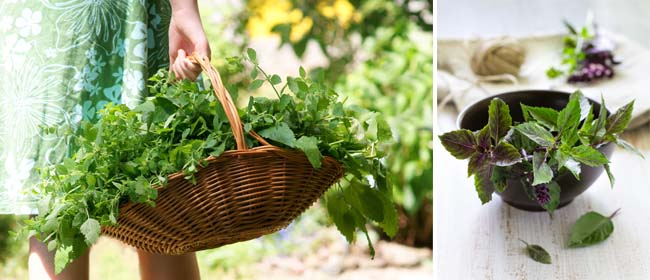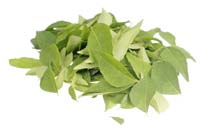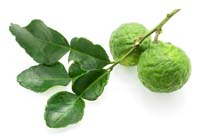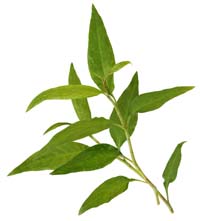 Lemon grass, curry leaves, kaffir lime, coriander (cilantro), Vietnamese mint and Asian basils – they’re all essential ingredients in Asian dishes. Lucky for us, they’re all reasonably easy to grow too.
Lemon grass, curry leaves, kaffir lime, coriander (cilantro), Vietnamese mint and Asian basils – they’re all essential ingredients in Asian dishes. Lucky for us, they’re all reasonably easy to grow too.
See the two Asian marinade recipes at the bottom of this article.
Lemon grass
 The citrusy flavour of lemon grass (Cymbopogon citratus) is used extensively in Southeast Asia, typically for flavouring soups, stir-fries, curries, pastes and salad dressings. Whole stalks are added to the pot when cooking (snip off the top leafy bit and bruise the base) or the bottom 15cm is sliced or minced (remove the tough outer layers first) and added to stir-fries, marinades and dressings, or stuffings for poultry and fish.
The citrusy flavour of lemon grass (Cymbopogon citratus) is used extensively in Southeast Asia, typically for flavouring soups, stir-fries, curries, pastes and salad dressings. Whole stalks are added to the pot when cooking (snip off the top leafy bit and bruise the base) or the bottom 15cm is sliced or minced (remove the tough outer layers first) and added to stir-fries, marinades and dressings, or stuffings for poultry and fish.
Lemon grass is a tall arching perennial that grows in clumps up to 1m high by 2m wide, although regular harvesting will keep plants much smaller than that.
It likes a warm, frost-free home, but it can easily be planted in containers in cooler areas and shifted indoors during winter. Or grow them indoors year-round. They’re quite happy growing as houseplants if they’re positioned in direct sunlight. High temperatures and direct sunshine are conducive to better flavour.
Plant in fertile, free-draining soil in full sun. Or use a good quality potting mix for containers. They like lots of compost, so dig it in before planting.
Lemon grass will tolerate poor soils, so long as there is adequate moisture and good drainage. Water plants regularly and feed with a fertiliser that’s high in nitrogen to maximise growth.
You can get plants from garden centres or sow seeds in pots to transplant later. Germination is slow and erratic though, so be patient.
Another way to propagate lemon grass is to place stalks bought from a greengrocer’s in a jar of water. Place on a sunny windowsill and in a few weeks roots will form. Remember to change the water regularly while the roots are developing. You can then pot them up and grow them on to form plants.
You can also propagate new plants by dividing established clumps into groups of two or three stolons.
Lemon grass is dormant in winter and leaves will turn brown. In spring, remove the brown leaves and cut back to 10cm above the stems. Then continue to supply water, fertiliser, sunlight and humidity and your plants will continue to produce their aromatic leaves.
Curry leaves
 The curry plant (Murraya koenegii) is a small tree whose pungent leaves are used in Indian and Asian cuisine. When bruised they emit a warm spicy aroma and impart a lovely curry flavour to dishes. The leaves can be added whole to the pot and removed before serving, or chopped or minced for use in pastes, powders, marinades and chutneys. Whole leaves are also used to flavour rice.
The curry plant (Murraya koenegii) is a small tree whose pungent leaves are used in Indian and Asian cuisine. When bruised they emit a warm spicy aroma and impart a lovely curry flavour to dishes. The leaves can be added whole to the pot and removed before serving, or chopped or minced for use in pastes, powders, marinades and chutneys. Whole leaves are also used to flavour rice.
The curry plant is fairly difficult to propagate which is why you don’t find it in very many nurseries in temperature regions. When a garden centre receives a supply of them, they sell out fairly quickly. If you see a plant for sale, snap it up quickly.
These plants like a sunny, sheltered spot away from frosts. They’re fairly slow growing, so they’re ideal for growing in containers. Grow it in a pot if you live in a cool area and bring it indoors over winter.
The curry plant likes a fertile, free-draining soil with lots of humus, so dig in plenty of compost. Apply a balanced fertiliser in spring.
Kaffir lime
 Kaffir lime (Citrus hystrix) is indispensible in Asian cuisine, but it’s the leaves, rather than the fruit, that are mostly used. The leaves can be distinguished from other citrus by their piggy-back nature. They grow in pairs, one leaf starting at the end of the other, and they exude the most delicious scent when brushed against or crushed.
Kaffir lime (Citrus hystrix) is indispensible in Asian cuisine, but it’s the leaves, rather than the fruit, that are mostly used. The leaves can be distinguished from other citrus by their piggy-back nature. They grow in pairs, one leaf starting at the end of the other, and they exude the most delicious scent when brushed against or crushed.
The knobby fruit has little juice, and what there is is sour. The juice is rarely utilised, though the rind is often added to dishes.
Nothing compares to the flavour that the leaves and rind of kaffir lime impart – they are unique, with their sharp lemony-lime taste. Both are added to a range of Asian dishes, including curries, soups and stir-fries. Kaffir lime is an ingredient in Thailand’s famous Tom Yum soup, and Indonesians use it to flavour soy sauce. Added at the start of cooking, kaffir lime slowly releases its aromatic flavouring.
Kaffir lime trees are frost tender, so in cooler regions they should be grown in pots to bring indoors over winter. Outdoors, choose a warm, sunny spot away from cold winds. Although they likes moisture, the soil must be free-draining. Dig in plenty of compost before planting. Mulch the soil in summer too to keep the shallow roots cool, but keep it away from the trunk to prevent collar rot.
Foliar feed during the growing season.
Basils
 Holy basil (pictured), Thai basil and lemon basil are all prominent in Southeast Asian cuisine. Holy basil (Ocimum sanctum), aka sacred basil (it’s sacred in the Hindu religion) is spicy, not sweet, with a lovely aroma of cloves and musk. It has slightly serrated leaves and pink flowers, and it’s often used in stir-fries and noodle dishes with chicken of seafood.
Holy basil (pictured), Thai basil and lemon basil are all prominent in Southeast Asian cuisine. Holy basil (Ocimum sanctum), aka sacred basil (it’s sacred in the Hindu religion) is spicy, not sweet, with a lovely aroma of cloves and musk. It has slightly serrated leaves and pink flowers, and it’s often used in stir-fries and noodle dishes with chicken of seafood.
Thai basil (Ocimum basilicum) is sweeter and similar in taste to ordinary basil. The difference is that it has a slightly anise flavour. Its stems are red and its flowers lavender and white, giving the plant ornamental appeal in the garden. Also called Asian basil or Asian sweet basil, it’s used extensively in Thai cuisine, flavouring curries and soups and added fresh to salads.
Lemon basil (Ocimum basilicum var. citriodorum) has small, lemon-scented leaves, which are often used for flavouring seafood. It’s also used in soups and fresh salads. Its seeds, like many other basil seed, become gelatinous when soaked in water or coconut milk and are used to flavour drinks and desserts.
All three basils are easily grown from seed. They need warmth to thrive, so plant in a sunny position in free-draining soil that’s been enriched with compost.
Vietnamese mint
 We may call it Vietnamese mint, but overseas this pungent herb is known as Vietnamese coriander, laksa plant or hot mint. Yet Persicaria odorata is neither a mint nor a coriander (though it spreads like mint and its hot peppery flavour is similar to coriander with a hint of lemon). Famously used in Singaporean laksa – and infamously used in Vietnamese herbal remedies to repress sexual urges – Vietnamese mint is also added to raw salads or Vietnamese spring rolls. The older the leaves the hotter the flavour, so try the younger leaves first before moving on to more mature ones.
We may call it Vietnamese mint, but overseas this pungent herb is known as Vietnamese coriander, laksa plant or hot mint. Yet Persicaria odorata is neither a mint nor a coriander (though it spreads like mint and its hot peppery flavour is similar to coriander with a hint of lemon). Famously used in Singaporean laksa – and infamously used in Vietnamese herbal remedies to repress sexual urges – Vietnamese mint is also added to raw salads or Vietnamese spring rolls. The older the leaves the hotter the flavour, so try the younger leaves first before moving on to more mature ones.
Vietnamese mint grows best in moist soil and will survive quite happily in shallow water like the edge of a pond or in bog gardens. It likes warmth too, so in cooler areas grow it in a pot to bring indoors over winter. Pinch it back regularly to encourage fresh bushy growth. If left to its own devices, Vietnamese mint can before tall and leggy. Apply a liquid fertiliser once a month during spring and summer.
If you can’t find this herb at your local garden centre, take a trip to your nearest Asian grocery store and buy a bunch (it may be sold under its Vietnamese name, rau ram, or Malaysian and Singaporean names daun kesom or daun laksa). Place the stems in water and roots will soon sprout.
Coriander (cilantro)
 A member of the umbelliferae family – the same as parsley and fennel – all parts of the coriander plant (Coriandrum sativum) are edible: the leaves, often referred to as cilantro, the seeds and the roots. It’s used in many cuisines, such as Thai, Chinese, Middle Eastern, Indian and African, traditionally in curries but also in desserts and sweet pastries. It’s a large part of Texan and Mexican food too.
A member of the umbelliferae family – the same as parsley and fennel – all parts of the coriander plant (Coriandrum sativum) are edible: the leaves, often referred to as cilantro, the seeds and the roots. It’s used in many cuisines, such as Thai, Chinese, Middle Eastern, Indian and African, traditionally in curries but also in desserts and sweet pastries. It’s a large part of Texan and Mexican food too.
The slightly sweet, citrus-like flavour of the seeds complements many foods, including chicken, pork, lamb, fish, even fruit. They’re also regularly thrown into pickles, sauces and chutneys and soups and stews. The leaves, which are fairly pungent with a faint lemony note, are tasty in soups or sprinkled over pasta dishes, green beans, new potatoes and salmon.
The roots have a more intense flavour than the leaves and are traditionally cooked as a vegetable or used in making curry pastes – and the non-squeamish use it to flavour the famed French and Chinese delicacy, frogs legs.
Coriander is an annual that grows best in the cooler seasons. During hot weather, plants quickly go to seed. Grow from seed in spring or autumn. Sow seed directly in the ground every two to four weeks for a continuous supply. Full sun is best in cooler climates or when growing in early spring or late autumn. Part shade is best in hot spots and during the heat of summer. Feed regularly with liquid fertiliser to promote luscious leaf growth.
Add leaves to dishes just before serving, as the taste and smell evaporates after prolonged cooking. For a spicy twist, use coriander leaves as a substitute for basil in pesto.
Lemon grass and chilli marinade
1 stalk lemon grass
1 fresh chilli, chopped and deseeded
1 clove garlic, chopped
1/4 cup chopped coriander (cilantro)
3 tablespoons peanut oil
2 tablespoons fish sauce
2 teaspoon palm sugar (or brown sugar)
Using the bottom 15cm or so of your lemon grass stalk, remove the outer layers and chop finely. Place in a bowl with all other ingredients and mix well. Use as a marinade for fish and poultry. Marinate for at least 1 hour.
Thai basil coconut marinade
Handful Thai basil leaves
2 kaffir lime leaves, roughly chopped
2 cloves garlic
1 shallot
2cm piece ginger, roughly chopped
2 tablespoons fish sauce
200ml coconut milk
Juice of half lime
2 teaspoons ground coriander
Half teaspoon chilli flakes (more if desired)
Place all ingredients in a food processor and blend until smooth. Use for marinating fish.
 My Favourites
My Favourites









Use a garden diary to look both backwards and forwards. Care of your plant or tree can be entered in the diary as a reminder to feed or prune at the time of planting or later. Also enter any comment on the effect of weather or pet/child/husband on the plant.